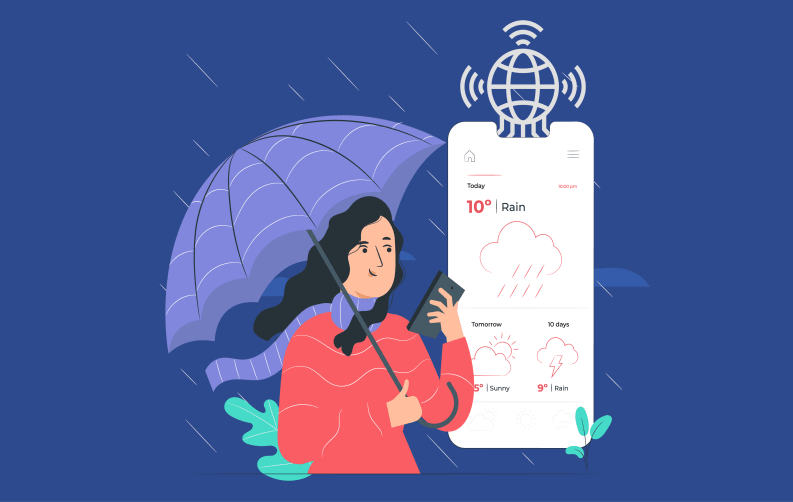
A data by Our World in Data states that Natural disasters are responsible for 60,000 deaths per year globally on average. Earthquakes, floods, typhoons, and many other types of weather disasters haunt this world almost every day. Now, even though we have developed a lot technologically, the danger is still far from getting over in regards to the unpredictable natural disasters.
Luckily, we have a potential weapon that can and is being useful to keep ourselves against such calamities- the Internet of Things (IoT). The IoT in weather technologies is expanding its applications faster. Thus, we already see a few examples of the IoT in weather technologies such as weather applications, meteorology sensors, and weather forecasting among others.
Now, as time is moving forward and technology is evolving, organizations such as IBM are focusing on boosting the efficiency of such weather technologies by using the IoT. The focus is revolving around improving the forecast accuracy so that people can avoid disasters.
Applications of the IoT in weather technologies
Moving further, let’s dive into the discussion of how IoT is useful for the digital weather management system. We will pick a few real-life examples and discuss them through short briefs about them.
The Weather of Things (WoT) is using remote sensors to collect data
Now, IoT has collected weather data through the network of these sensors for quite some time. It visualizes the real-time data to predict weather developments. Metrics such as air pressure, temperature, wind speed, and more are taken into account to develop the finalized data and prepare a weather forecast report. With time, tech giants such as IBM are focusing on improving the predictability of such devices of weather forecasting.
These fascinating remote sensors are in-built in our everyday technologies such as a few car models, windmills, drones, and more. The IoT network collects the data and sends it to the monitoring computer assigned to control these devices. Moreover, weather forecasters were dependent upon Government-institutions to collect such information due to the high costs. But, for a few business owners, these weather models are getting affordable. Thus, the privatization of the WoT technology might improve as well.
Weather applications are dependent on WoT data
A part of IBM, The Weather Company, has constructed a cloud computing system with the capability to deliver four GP data per second. The data is used to respond to 26 billion requests every day. Now, if we take the smartphone applications as an example- these mobile applications are dependent on third-party weather data.
For instance, Accuweather uses weather data from agencies such as the National Weather Service to predict the weather. Moreover, outside the US, it had tied up with many government and private agencies to borrow the data collected by them through the IoT technology.
Benefits of Weather APIs into mobile and web applications
Weather APIs are entirely dependent on the IoT network to access the data. However, these weather APIs developed by tech giants such as IBM provide weather data integration in the required format.
Now, let’s discuss a few benefits that these weather APIs offer-
- Weather applications can provide historical, present, and predicted weather forecasts due to these APIs
- Anticipation of market trends that get affected by the weather developments
- Prediction for improved safety measures to save lives more effectively
- Real-time weather patterns to provide possible weather developments that might occur
- IBM’s weather APIs can provide comprehensive temperature forecasts and precipitation patterns for the duration of up to 7 months in the future
- IBM’s weather APIs offer a high-resolution weather observation network with the highest quality mark possible with modern technology
- The network uses more than 250,000 personal weather stations apart from the other regular resources
Conclusion- The future of WoT
The WoT has a future entirely focused on improved accuracy. And to do that, organizations are working on making IoT technology more accessible and remote-friendly. With networks of resources such as vehicles, towers, satellites, and smart devices, the weather data collection might witness improved accuracy. Thus, we might enter into an era where apps could even predict natural disasters such as Earthquakes, and tycoons much more efficiently compared to what we have today. Improved IoT will not contribute to enhanced accuracy of weather forecasting, but will also save so many lives.

Sr. Content Strategist
Meet Manish Chandra Srivastava, the Strategic Content Architect & Marketing Guru who turns brands into legends. Armed with a Masters in Mass Communication (2015-17), Manish has dazzled giants like Collegedunia, Embibe, and Archies. His work is spotlighted on Hackernoon, Gamasutra, and Elearning Industry.
Beyond the writer’s block, Manish is often found distracted by movies, video games, AI, and other such nerdy stuff. But the point remains, If you need your brand to shine, Manish is who you need.













